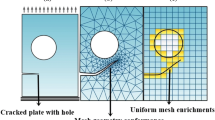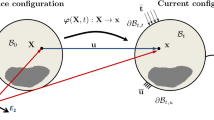Abstract
The present paper focuses on composite structures which consist of several layers of carbon fiber reinforced plastics (CFRP). For such layered composite structures, delamination constitutes one of the major failure modes. Predicting its initiation is essential for the design of these composites. Evaluating stress-strength relation based onset criteria requires an accurate representation of the through-the-thickness stress distribution, which can be particularly delicate in the case of shell-like structures. Thus, in this paper, a solid-shell finite element formulation is utilized which allows to incorporate a fully three-dimensional material model while still being suitable for applications involving thin structures. Moreover, locking phenomena are cured by using both the EAS and the ANS concept, and numerical efficiency is ensured through reduced integration. The proposed anisotropic material model accounts for the material’s micro-structure by using the concept of structural tensors. It is validated by comparison to experimental data as well as by application to numerical examples.














Similar content being viewed by others
References
Ladevze, P., Nouy, A.: On a multiscale computational strategy with time and space homogenization for structural mechanics. Comput. Methods Appl. Mech. Eng. 192, 3061–3087 (2003)
Kouznetsova, V.G., Geers, M.G.D., Brekelmans, W.A.M.: Multiscale second order computational homogenization of multi-phase materials: a nested finite element strategy. Comput. Methods Appl. Mech. Eng. 193, 5525–5550 (2004)
Violeau, D., Ladevze, P., Lubineau, G.: Micromodel-based simulations for laminated composites. Compos. Sci. Technol. 69(9), 1364–1371 (2009)
Zienkiewicz, O.C., Taylor, R.L.: The Finite Element Method for Solid and Structural Mechanics, 6th edn. Elsevier, Amsterdam (2005)
Kanoute, P., Boso, D.P., Chaboche, J.L., Schrefler, B.A.: Multiscale methods for composites: a review. Arch. Comput. Methods Eng. 16, 31–75 (2009)
Klusemann, B., Svendsen, B.: Homogenization modeling of thin-layer-type microstructure. Int. J. Solids Struct. 49(13), 1828–1838 (2012)
Holzapfel, G.A.: Determination of material models for arterial walls from uniaxial extension tests and histological structure. J. Theor. Biol. 238, 290–302 (2006)
Gasser, T.C., Ogden, R.W., Holzapfel, G.A.: Hyperelastic modelling of arterial layers with distributed collagen fibre orientations. J. Royal Soc. Interface 3, 15–35 (2006)
Ansar, M., Xinwei, W., Chouwei, Z.: Modeling strategies of 3D woven composites: a review. Compos. Struct. 93(8), 1947–1963 (2011)
Lomov, S., Ivanov, D., Verpoest, I., et al.: Full-field strain measurements for validation of meso-FE analysis of textile composites. Compos. Part A 39(8), 1218–1231 (2008)
Toledo, M., Nallim, L., Luccioni, B.: A micro-macromechanical approach for composite laminates. Mech. Mater. 40(11), 885–906 (2008)
Reese, S.: Meso-macro modelling of fiber-reinforced rubber-like composites exhibiting large elastoplastic deformation. Int. J. Solids Struct. 40, 951–980 (2003)
Hashin, Z., Rotem, A.: A fatigue failure criterion for fiber reinforced materials. J. Compos. Mater. 7, 448–464 (1973)
Ye, L.: Role of matrix resin in delamination onset and growth in composite laminates. Compos. Sci. Technol. 33(4), 257–277 (1988)
Davila, C.G., Johnson, E.R.: Analysis of delamination initiation in postbuckled dropped-ply laminates. AIAA J. 31, 721–727 (1993)
Camanho, P.P., Matthews, F.L.: Delamination onset prediction in mechanically fastened joints. J. Compos. Mater. 33, 906–927 (1999)
Turon, A., Camanho, P.P., Costa, J., Davila, C.G.: A damage model for the simulation of delamination in advanced composites under variable-mode loading. Mech. Mater. 38, 1072–1089 (2006)
O’Brien, T.K.: Interlaminar fracture toughness: the long and winding road to standardization. Compos. Part B 29(1), 57–62 (1998)
Liu, S.: Quasi-impact damage initiation and growth of thick-section and toughened composite materials. Int. J. Solids Struct. 31, 3079–3098 (1999)
Zou, Z., Reid, S.R., Li, S., Soden, P.D.: Modelling interlaminar and intralaminar damage in filament wound pipes under quasi-static indentation. J. Compos. Mater. 36, 477–499 (2002)
Tay, T.: Characterization and analysis of delamination fracture in composites: an overview of developments rom 1990 to 2001. Appl. Mech. Rev. 56(1), 1–32 (2003)
Krueger, R.: Virtual crack closure technique: history, approach, and applications. Appl. Mech. Rev. 57(2), 109–143 (2004)
de Borst, R., Remmers, J.J.C.: Computational modelling of delamination. Compos. Sci. Technol. 66, 713–722 (2006)
Balzani, C., Wagner, W.: An interface element for the simulatino of delamination in unidirectional fiber-reinforced composite laminates. Eng. Fract. Mech. 75, 2597–2615 (2008)
Cid Alfaro, M.V., Suiker, A.S.J., de Borst, R., Remmers, J.J.C.: Analysis of fracture and delamination in laminates using 3D numerical modelling. Eng. Fract. Mech. 76, 761–780 (2009)
Whang, C., Zhang, H., Shi, G.: 3D Finite element simulatin of impact damage of laminated plates using solid-shell interface elements. Appl. Mech. Mater. 130–134, 766–770 (2012)
Valente, R., Alves de Sousa, R., Natal Jorge, R.: An enhanced strain 3D element for large deformation elastoplastic thin shell applications. Comput. Mech. 34, 38–52 (2004)
Alves de Sousa, R., Cardoso, R., Valente, R., Yoon, J., Gracio, J., Natal Jorge, R.: A new one-point quadrature enhanced assumed strain (EAS) solid shell element with multiple integration points along thickness–Part II: nonlinear applications. Int. J. Numer. Methods Eng. 67, 160–188 (2006)
Reese, S.: A large deformation solid-shell concept based on reduced integration with hourglass stabilization. Int. J. Numer. Methods Eng. 69, 1671–1716 (2007)
Tan, X., Vu-Quoc, L.: Efficient and accurate multilayer solid-shell element: non-linear materials at finite strain. Int. J. Numer. Methods Eng. 63, 2124–2170 (2005)
Kim, K., Liu, G., Han, S.: A resultant 8-node solid-shell element for geometrically nonlinear analysis. Comput. Mech. 35, 315–331 (2005)
Klinkel, S., Gruttmann, F., Wagner, W.: A robust nonlinear solid-shell element based on a mixed variational formulation. Comput. Methods Appl. Mech. Eng. 195, 179–201 (2006)
Cardoso, R., Yoon, J., Mahardika, M., Choudhry, S., Alves de Sousa, R., Valente, R.: Enhanced assumed strain (EAS) and assumed natural strain (ANS) methods for one-point quadrature solid-shell elements. Int. J. Numer. Methods Eng. 75, 156–187 (2008)
Schwarze, M., Reese, S.: A reduced integration solid-shell element based on the EAS and the ANS concept–geometrically linear problems. Int. J. Numer. Methods Eng. 80, 1322–1355 (2009)
Schwarze, M., Vladimirov, I., Reese, S.: Sheet metal forming and springback simulation by means of a new reduced integration solid-shell finite element technology. Comput. Methods Appl. Mech. Eng. 200, 454–476 (2011)
Schwarze, M., Reese, S.: A reduced integration solid-shell finite element based on the EAS and the ANS concept - large deformation problems. Int. J. Numer. Methods Eng. 85, 289–329 (2011)
Roy, T., Manikandan, P., Chakraborty, D.: Improved shell finite element for piezothermoelastic analysis of smart fiber reinforced composite structures. Finite Elem. Anal. Des. 46(9), 710–720 (2010)
Yao, L.-Q., Lu, L.: An electric node concept for solid-shell elements for laminate composite piezoelectric structures. ASME J. Appl. Mech. 72, 35–43 (2005)
Moreira, R., Alves de Sousa, R., Valente, R.: A solid-shell layerwise finite element for non-linear geometric and material analysis. Compos. Struct. 92(6), 1517–1523 (2010)
Rah, K., Van Paepegem, W., Habraken, A., Alves de Sousa, R., Valente, R.: Evaluation of different advanced finite element concepts for detailed stress analysis of laminated composite structures. Int. J. Mater. Form. 2(1), 943–947 (2009)
Liu, P., Zheng, J.: Recent developments on damage modeling and finite element analysis for composite laminates: a review. Mater. Design 31(8), 3825–3834 (2010)
Kreja, I.: A literature review on computational models for laminated composite and sandwich panels. Cent. Eur. J. Eng. 1(1), 59–80 (2011)
Svendsen, B.: On the representation of constitutive relations using structure tensors. Int. J. Eng. Sci. 32, 1889–1892 (1994)
FEAP 8.3: University of California. www.ce.berkeley.edu/feap (2011)
Bischoff, M., Ramm, E.: Shear deformable shell elements for large strains and rotations. Int. J. Numer. Methods Eng. 40, 4427–4449 (1997)
Camanho, P.P., Bowron, S., Matthews, F.L.: Failure mechanisms in bolted CFRP. J. Reinf. Plast. Compos. 17(3), 205–233 (1998)
Author information
Authors and Affiliations
Corresponding author
Rights and permissions
About this article
Cite this article
Stier, B., Simon, JW. & Reese, S. Finite Element Analysis of Layered Fiber Composite Structures Accounting for the Material’s Microstructure and Delamination. Appl Compos Mater 22, 171–187 (2015). https://doi.org/10.1007/s10443-013-9378-8
Received:
Accepted:
Published:
Issue Date:
DOI: https://doi.org/10.1007/s10443-013-9378-8




